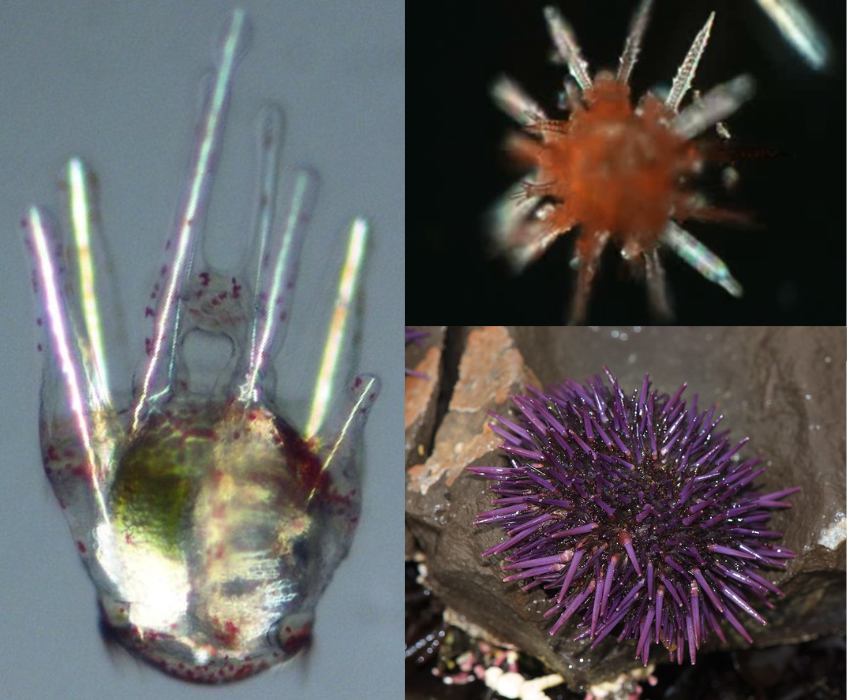Just an Arm’s Reach Away: The Role of Thyroid Hormones in Urchin Development
By Barbara Hyde-Lay
14 June 2023

Pacific purple sea urchins at different stages of development: larvea (left), juvenile (top right), and adult (bottom right). Photo credit: Andreas Heyland and Jerry Kirkhart (Creative Commons License).
Thyroid hormones play an important and unique role in many animals, and Dr. Andreas Heyland wants people to appreciate their role in invertebrates.
“Thyroid hormones play a critical role in human development — if they’re not there in the right quantity and at the right time, you’re in trouble,” says Heyland, a professor in the Department of Integrative Biology.
“The timing of hormones being released is very important in the proper development of not just people but animals as well…. including sea urchins.”
The Heyland lab studies developmental biology in aquatic organisms through an evolutionary lens. One of the lab’s many research projects is focused on the role of thyroid hormones in the development of the pacific purple sea urchin, Strongylocentrotus purpuratus, a well-known invertebrate with many beloved relatives such as starfish, brittle stars, and sea cucumbers.
Like many other invertebrates —and some well-known amphibian friends— purple sea urchins undergo metamorphosis, a process heavily reliant on programmed cell death (PCD).
“When frogs, for example, transition from tadpoles to juveniles, they undergo a process of tail regression where it is completely resorbed. This requires massive amounts of PCD across multiple tissues at a broad scale,” says Heyland.
The mechanisms behind metamorphosis and mass cell death in frogs and other vertebrates are well established – but much less so in invertebrates like sea urchins.
When sea urchins metamorphose from larvae to juvenile, they ‘settle’ onto the shoreline environment where they will mature into adults. This process, called settlement, involves the larvae arms retracting and being resorbed, but until now scientists knew very little about how this happens.
The arms of sea urchin larvae are microscopic (a mere 0.2 mm!) and are essential for the larvae to catch food to eat and to move around in the water to avoid predators.
“We know that the arms can change length in response to food availability or predation in the area; but thus far there has been no direct evidence for how this happens!” Heyland shared.
“Our previous work showed that thyroid hormones are involved in the settlement process when arm reduction begins. The next step, then, was to determine if PCD is the mechanism by which thyroid hormones drive arm retraction during settlement and metamorphosis.”
And so Hannah Wynen, a Master’s student in the Heyland lab, started exposing sea urchin larvae to different thyroid hormones and then watched the change in larval arm length and PCD levels.
She found that two of the thyroid hormones had a consistent and repeatable effect on arm reduction. She also discovered that PCD increased in response to these thyroid hormones, especially in larvae that had initiated metamorphosis.
Taken together, these results provide strong evidence that thyroid hormones help regulate arm retraction via PCD.
“No one had yet seen the connection between the thyroid hormones and the PCD in larval arm retraction,” says Heyland, explaining the impact of this discovery. “This process in other organisms is extremely well defined —and so we wanted to determine the pathway in the urchins.”
Moving forward, the Heyland group now plans to determine if cell death is necessary for settlement to occur and identify the signaling pathways between thyroid hormones and PCD.
“There is still a lot we don’t know yet about the fascinating process of metamorphosis in sea urchins, but establishing a link between developmental timing in the larvae and cell death is a good start,” says Heyland.
This study was funded by the Natural Sciences and Engineering Research Council (NSERC).
Read the full study in the Journal of Experimental Biology.
Read about other CBS Research Highlights.